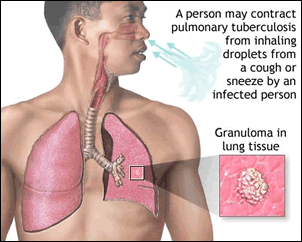 TB
is a major cause of death for people with HIV worldwide, especially
in low-income countries. Mortality rates are high among HIV/TB
coinfected patients who present for care with advanced disease,
but the optimal timing for ART initiation in relation to tuberculosis
therapy has been controversial.
TB
is a major cause of death for people with HIV worldwide, especially
in low-income countries. Mortality rates are high among HIV/TB
coinfected patients who present for care with advanced disease,
but the optimal timing for ART initiation in relation to tuberculosis
therapy has been controversial.
People who start ART
and experience large CD4 cell gains with untreated TB can develop
immune reconstitution inflammatory syndrome (IRIS) as the recovering
immune system starts to attacks existing pathogens in the body.
Furthermore, some commonly used anti-TB drugs can interact with
protease inhibitor
and NNRTI antiretroviral agents, potentially causing worse
side effects or compromising effectiveness.
In the present study, Salim Abdool Karim from the Centre for the
AIDS Programme of Research in South Africa and colleagues compared
simultaneous versus sequential treatment in 642 people with HIV
and TB in Durban, South Africa.
In this controlled open-label trial, 429 adult participants were
randomly assigned to receive integrated antiretroviral and anti-TB
therapy, starting ART either within 4 weeks of TB treatment initiation
(early integrated) or within 4 weeks after completing the intensive
phase (late integrated); 213 patients were assigned to begin sequential
ART within 4 weeks after completing TB treatment. Men and women
were about equally represented, and the average age was 34 years.
Participants all had a CD4 cell count < 500 cells/mm3, with
a low median of about 150 cells/mm3.
All patients received standard TB therapy according to South African
guidelines, which stipulate that a first episode of TB should
be treated with a 2-month intensive combination regimen of rifampin,
isoniazid, ethambutol, and pyrazinamide, followed by a 4-month
continuation regimen of isoniazid plus rifampin. Patients with
prior tuberculosis receive a 3-month intensive regimen (including
streptomycin for the first 2 months), followed by a 5-month continuation
phase. Patients were offered directly observed therapy by clinic
nurses, but some selected observers in their community, home,
or workplace. Participants also received prophylaxis with trimethoprim-sulfamethoxazole.
ART consisted of a once-daily regimen of didanosine
(ddI, Videx), lamivudine
(3TC, Epivir), and efavirenz
(Sustiva or Stocrin).
In September 2008, based on interim data, a data and safety monitoring
committee recommended that the sequential therapy arm should be
halted ahead of schedule and those patients should start ART;
the 2 integrated therapy groups continued. The recently published
analysis includes data from the combined integrated therapy groups
and the sequential therapy group up to that point.
Results
 |
Patients
in the 2 integrated therapy groups had a significantly lower
rate of death than those in the sequential therapy group (5.4
vs 12.1 deaths per 100 person-years). |
 |
This
difference represented a relative risk reduction of 56% (hazard
ratio 0.44 for the integrated therapy arm). |
 |
Mortality
was lower in the integrated therapy groups compared with the
sequential treatment group at all CD4 cell levels. |
 |
Among
patients with CD4 counts < 200 cells/mm3 (indicative of
AIDS), the mortality rate was 46% lower in the integrated
therapy groups compared with the sequential therapy group. |
 |
Although
the number of deaths among patients with 200-500 cells/mm3
was small, there was a trend toward lower mortality in the
integrated therapy groups. |
 |
12.4%
of patients in the integrated therapy groups developed IRIS,
compared with only 3.8% in the sequential therapy group; however,
there were no required ART changes or deaths due to IRIS. |
 |
Rates
of serious (grade 3 or 4) adverse events not related to IRIS
were similar in the integrated and sequential therapy arms
(30 vs 32 per 100 person-years). |
Based on these findings, the study authors concluded, "The
initiation of antiretroviral therapy during tuberculosis therapy
significantly improved survival and provides further impetus for
the integration of tuberculosis and HIV services."
"The interval between the completion of tuberculosis therapy
and the initiation of antiretroviral therapy is important; a considerable
number of deaths in the sequential-therapy group occurred during
this time," they elaborated in their discussion. "Once
antiretroviral therapy was initiated, however, it was associated
with similarly high levels of viral suppression in the two study
groups."
Since even participants with relatively high CD4 counts of 200-500
cells/mm3 benefited from integrated therapy, the investigators
suggested that treatment guidelines should recommend integrated
therapy for everyone with a CD4 count < 500 cells/mm3. World
Health Organization (WHO) antiretroviral guidelines in effect
at the time of this study called for ART below 200 cells/mm3,
but the threshold
was recently raised to 350 cells/mm3, closer to guidelines
for high-income countries.
Centre for the AIDS Programme of Research in South Africa (CAPRISA),
University of KwaZulu-Natal, Durban, South Africa; Department
of Epidemiology and International Center for AIDS Care and Treatment
Programs (ICAP), Mailman School of Public Health, Columbia University,
New York, NY; Department of Internal Medicine and Epidemiology,
Yale University School of Medicine, New Haven, CT.
3/26/10
Reference
SS
Abdool Karim, K Naidoo, A Grobler, and others. Timing of Initiation
of Antiretroviral Drugs during Tuberculosis Therapy. New England
Journal of Medicine 362(8): 697-706 (Free
full text). February 25, 2010.
